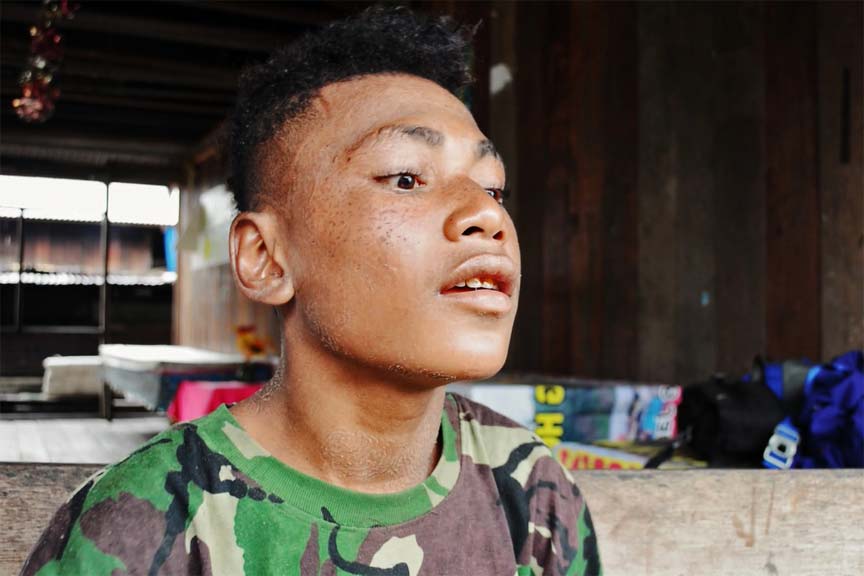Kaskado: A Skin Disease Typical of Eastern Indonesia

The roaring sound of waves can be heard from a house on Mbromsi Island, Biak Numfor Regency, Papua. There is nothing special about this house, with a tin roof and cement floor. In the part of the house with wooden walls, the sea breeze infiltrates through the cracks. The atmosphere is enlivened by a number of small children who are playing with pets. The children are the children of the house owner, Maurit Amos Rumbia.
When the doctorSHARE team conducted Medical Services on Mbromsi Island, Maurit registered as a patient. The man who works as a fisherman complained about his skin health condition. Maurit’s skin looked like scaly and peeled off the outer skin. Almost all over his body, the skin was found in the same condition. According to him, this skin condition disturbs him when he works. When he sweats, he often feels itchy and scratches it.
Since the age of six, Maurit has lived with skin health problems. Maurit once felt embarrassed when he was still in school. It was not uncommon for Maurit’s colleagues at school to stay away from him for fear of infection. “When I was in elementary school and junior high school, I already had this disease, so I was disturbed in my studies, and I didn’t have good friends because of this. So until I graduated from high school, I didn’t get along well,” said Maurit.
A similar complaint was also encountered by the doctorSHARE team while conducting Medical Services in Sentani District, Jayapura Regency, Papua. Fransisco Dickson, a student who came for treatment accompanied by his mother. Fransisco’s skin condition is not much different from Maurit, such as scaly and peeling on the outside. Fransisco’s biological mother, Estherio Yoku, believes the cause of her son’s skin disease is dirty water.
The peeling skin, if noticed, forms a pattern like carvings or drawings on batik cloth. They are scattered all over the body, but are generally located on the neck to the chest. People in Papua usually call it Kaskado disease. People can recognize Kaskado based on identification of its distinctive shape or pattern.
A dermatologist in Biak, Dr. Irene Mariani Santoso, Sp.KK explained that Kaskado disease is called Tinea Imbrikata in medical terms. Kaskado is a skin infection caused by the fungus Trichophyton Concentricum. The uniqueness of Kaskado according to Dr. Irene is that it is only found in Eastern Indonesia.
“The symptoms of the fungus on the skin are scales that look like carvings. So we say it’s Polycyclic, the shape is circular like arranged concentrically like tiles, if the theory is like that,” said Dr. Irene.
Kaskado transmission starts from human-to-human contact, the contact is not short-lived. Family, playmates, and neighbors have the potential to infect each other if one of them has Kaskado. Maurit, for example, was told by his parents that he contracted Kaskado from his neighbor when he was six years old.
“For Kaskado, I asked my parents why I got Kaskado, it was transmitted from a neighbor when I was six years old. I played with my neighbor and it turned out that Kaskado was infected to me,” said Maurit when met in his yard.
According to Dr. Irene, Kaskado treatment takes a long time. Tinea Imbrikata fungal infection usually takes up to four weeks to take medication. Medicines for Kaskado are not difficult to obtain, people can get these drugs at the Puskesmas. The difficulty of recovering from Kaskado is due to the patient’s compliance when taking medication. If you routinely take medicine as recommended by the doctor, of course Kaskado can be cured.
“Sometimes patients are not diligent, so for example they have been taking medicine for one week. When the feeling starts to disappear, he stops, even though the fungus is still there, it’s just hidden,” explained Dr. Irene.
Kaskado sufferers can recover within four weeks if they take the medicine regularly. If not routine, Kaskado will indeed disappear but then reappear. Then the healing time will be longer, namely six to eight months. “It only takes patient compliance in taking the medicine, an explanation to the patient that this is indeed a long time to take the medicine,” concluded Dr. Irene.
Preventing Kaskado is not too difficult. It is only necessary to maintain body hygiene by bathing regularly using an antiseptic. Kaskado easily attacks the skin when the skin is left in a dirty condition. For example, after sweating from a day’s work or after swimming in the sea. A clean and healthy lifestyle is the main key in preventing diseases that attack the body.
